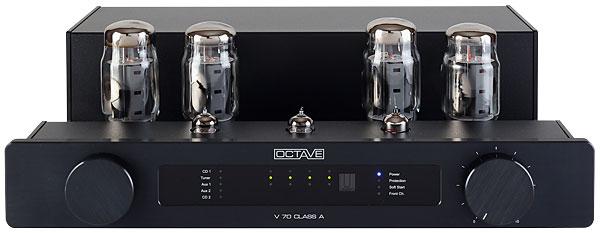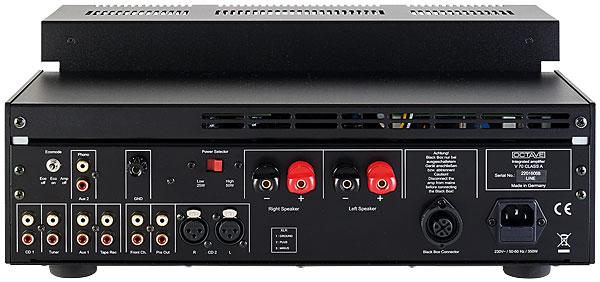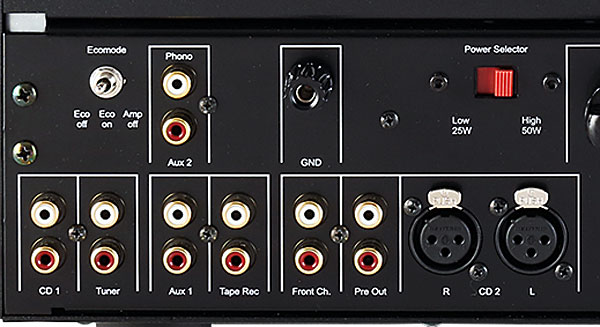Octave Audio V70 Class A Integrated Amplifier

 Stalwart of Germany's single-ended tube scene, Octave Audio also produces hybrid and push-pull amplifiers, including the 'Class A' V70 integrated featured here
Stalwart of Germany's single-ended tube scene, Octave Audio also produces hybrid and push-pull amplifiers, including the 'Class A' V70 integrated featured here
Which are you? The minimalist who wants an integrated valve amp bearing only clearly-labelled inputs, source selector, volume control and speaker terminals? Or do you prefer a 'fully loaded' device with total flexibility? The former is intuitive, and any experienced hi-fi user thinks of such units as virtually 'plug 'n' play'. Germany's 30-year-veteran brand Octave Audio has, in its V70 Class A, an amp that sits between both camps and yet I was compelled to digest its 36-page manual.
That's despite our unit being the £8500 base model without optional MM or MC phono stages (£450 per board, and the V70 takes only one so you'll need to decide which type you prefer), or either of the power-boosting capacitor banks. The £900 Black Box is 'an external Power Supply Booster', the £2500 Super Black Box 'an external Power Supply Booster with Enhanced Capacity'. This seems quite steep for outboard capacitor banks, linked to the rear of the V70 via an umbilical, so I'd advise demos with and without if you're a potential purchaser. But even without these options, there's much to explain.
Handsome Beast
Externally, the V70 Class A, available in black or silver, is a handsome beast let down only by the folded-steel valve cover. It's certainly robust but looks, to my eyes, like it came from some industrial heater, and not in keeping with the rest of this classy component. Visually, the V70 sans cover is a treat, so you could leave it off if you're in a kids/pet-free home.
Shipped with the tubes in a separate box, the first task is to remove the cover via its screws, fit the valves and refit the lid (if so desired). The front panel is control-free save for two knobs, as the power on/off rocker is on the left-hand side of the case and the rest of the switches are on the back. The left rotary selects the source and bias-related operation, the right is the motorised volume control.
This comes with a beautifully-made remote with nice heft, which operates only the volume control. That's no hardship when one considers how rarely one needs a remote for anything else. When you change sources, you probably have to get up anyway to put on an LP or CD, streaming options notwithstanding.
In between the rotaries is a display with two columns of green LEDs and a central, horizontal row of four LEDs. This panel provides visual status of tube health, when the warm-up procedure is over, any malfunctions, etc. The left-hand column shows the five inputs and Aux 2 becomes the phono input if either board is fitted.

Eco Warrior
Meanwhile, the right-hand column indicates the power-on sequence, and the choice of operation as a two-channel power amp (if incorporated into a home cinema, for example). The LEDs in the middle show individual valve status.
As soon as you look at the back of the amp, you will understand why I suggest a cup of tea and a study of the manual. The usual sockets include beefy, multi-way binding posts, an AC mains input, sufficient RCA phonos for the line sources, a pair of XLRs for a balanced source component and an earthing terminal which you'll need if you fit the optional phono stage. But the rest need explaining…

As seen from the back, the upper left-hand corner sports a three-way toggle labelled 'Ecomode' with settings of Eco off, Eco on and Amp off. This controls the automatic shut-off system which goes into standby if there is no music signal for seven minutes. Ecomode works in conjunction with the slow-start operation from switch-on, which is monitored through the front panel display. Next is the power selector switch for 'Low 25W' and 'High 50W'. The setting is determined by the choice of output valves, more of which in a moment. Lastly, there's the special connector for either of the Black Box capacitor banks, situated next to the AC mains input.
PM discusses the 'Class A' feature of this push-pull amp in his boxout but this is not tube-specific for at the heart of the Octave V70 Class A, shipped in standard guise, is the ever-popular KT120. Of course, Octave's V70 is not alone in handling a choice of octal-based output tubes – indeed, its V70 SE variant comes fitted with venerable 6550s.

























































